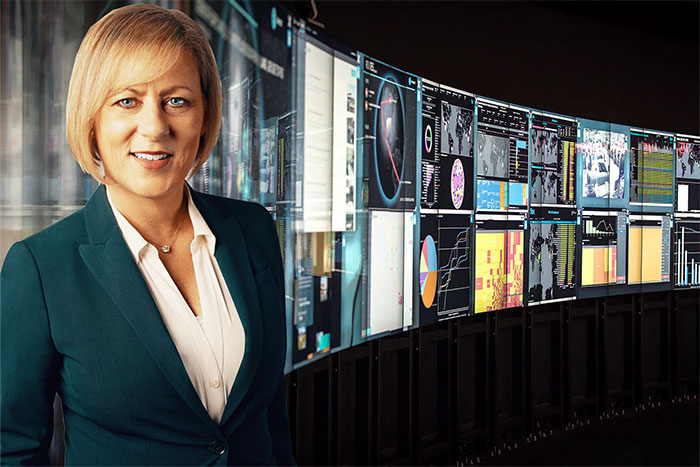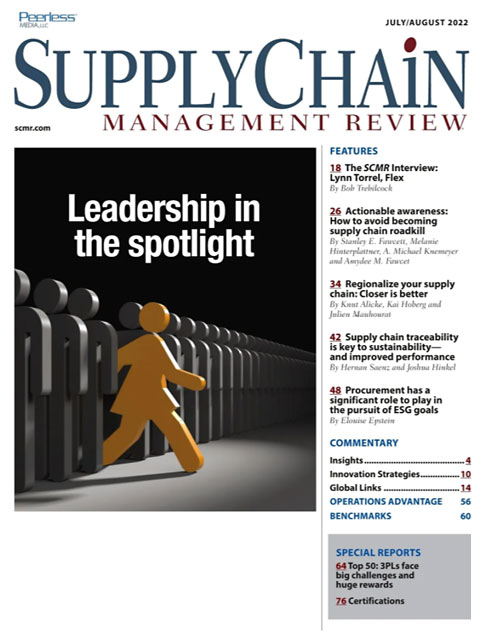Sorry, but your login has failed. Please recheck your login information and resubmit. If your subscription has expired, renew here.
July-August 2022
In late May, I attended the Institute for Supply Management’s first live conference since 2019. The message from Tom Derry, ISM’s CEO, was simple: These are challenging times, but along with the challenges come opportunities for those of us who can step up and lead our organizations into the future. One area where supply chain will be tasked with stepping up to the plate is going to be ESG, the initialism for environmental, social and governance. It was a major theme of the conference, and while all of the reporting requirements are still being debated, there’s little question that supply chain will lead the charge in environmental initiatives… Browse this issue archive.Need Help? Contact customer service 847-559-7581 More options
SCMR: Lynn, given that Flex is often behind the scenes, the company may not be a household name to all of our readers. What’s your elevator speech for how you describe Flex and what it does?
TORREL: We are a $26 billion global manufacturer, with more than 160,000 employees across 30 countries, and we manufacture a wide range of products for a diverse set of companies efficiently and effectively using our global scale and scope, as well as our unique capabilities. My team’s role within the organization is to make sure we have everything we need in the right place, at the right time, in the right quantity, and at the right cost to enable the successful production of those products.
SCMR: You’ve had procurement and a supply chain titles. What drives the Flex supply chain?
TORREL: That’s a great question because our structure is unique. As a diversified manufacturer it is valuable to have procurement and the broader supply chain functions all in one organization. Because it’s not just a matter of negotiating the right price for components, but making sure you have in place all of the inventory and logistics to enable manufacturing as well as focusing on the total cost of ownership.
Our customers are outsourcing their manufacturing to Flex so we work to earn their trust every day. To do that, we have made tremendous investments over the years in our global procurement practices and our digitalized supply chain, which is one of the most advanced in the world.
SCMR: Give us some idea of the scope of your supply chain.
TORREL: We manage supply chains on behalf of 1,000 customers. That alone makes us unique. We also work on a direct basis with 16,000 suppliers, which translates into 1 million SKUs. We work across multiple verticals including industrial products, consumer devices, health care, automotive, communications, enterprise, cloud and lifestyle. We also have strong partnerships with our preferred suppliers and providers. Our digital tools provide end-to-end visibility that companies need—from design through manufacturing to delivery—when they are looking for a partner to manufacture their products.
SCMR: You just described involvement from conception to grave. Was it always this way?
TORREL: No. Flex started out as an outsourced manufacturer. Then, as we evolved, we developed value-added services such as design capabilities. Customers would bring us their initial design, and we would look at what could be done to make the design more efficient for manufacturing. We could then recommend suppliers with expertise in that final design.

This complete article is available to subscribers only.
Log in now for full access or start your PLUS+ subscription for instant access.
SC
MR
Sorry, but your login has failed. Please recheck your login information and resubmit. If your subscription has expired, renew here.
July-August 2022
In late May, I attended the Institute for Supply Management’s first live conference since 2019. The message from Tom Derry, ISM’s CEO, was simple: These are challenging times, but along with the challenges come… Browse this issue archive. Access your online digital edition. Download a PDF file of the July-August 2022 issue.SCMR: Lynn, given that Flex is often behind the scenes, the company may not be a household name to all of our readers. What’s your elevator speech for how you describe Flex and what it does?
TORREL: We are a $26 billion global manufacturer, with more than 160,000 employees across 30 countries, and we manufacture a wide range of products for a diverse set of companies efficiently and effectively using our global scale and scope, as well as our unique capabilities. My team’s role within the organization is to make sure we have everything we need in the right place, at the right time, in the right quantity, and at the right cost to enable the successful production of those products.
SCMR: You’ve had procurement and a supply chain titles. What drives the Flex supply chain?
TORREL: That’s a great question because our structure is unique. As a diversified manufacturer it is valuable to have procurement and the broader supply chain functions all in one organization. Because it’s not just a matter of negotiating the right price for components, but making sure you have in place all of the inventory and logistics to enable manufacturing as well as focusing on the total cost of ownership.
Our customers are outsourcing their manufacturing to Flex so we work to earn their trust every day. To do that, we have made tremendous investments over the years in our global procurement practices and our digitalized supply chain, which is one of the most advanced in the world.
SCMR: Give us some idea of the scope of your supply chain.
TORREL: We manage supply chains on behalf of 1,000 customers. That alone makes us unique. We also work on a direct basis with 16,000 suppliers, which translates into 1 million SKUs. We work across multiple verticals including industrial products, consumer devices, health care, automotive, communications, enterprise, cloud and lifestyle. We also have strong partnerships with our preferred suppliers and providers. Our digital tools provide end-to-end visibility that companies need—from design through manufacturing to delivery—when they are looking for a partner to manufacture their products.
SCMR: You just described involvement from conception to grave. Was it always this way?
TORREL: No. Flex started out as an outsourced manufacturer. Then, as we evolved, we developed value-added services such as design capabilities. Customers would bring us their initial design, and we would look at what could be done to make the design more efficient for manufacturing. We could then recommend suppliers with expertise in that final design.
SC
MR


Latest Supply Chain News
Latest Podcast

 Explore
Explore
Business Management News
- The hard job of teaching soft skills
- Trump picks former Wisconsin congressman Sean Duffy for DOT secretary
- Made in Mexico, manufactured by China
- Retail sales see gains in October, reports Commerce and NRF
- Balancing green and speed: Home delivery insights from the pandemic era
- AdventHealth named top healthcare supply chain by Gartner
- More Business Management
Latest Business Management Resources

Subscribe

Supply Chain Management Review delivers the best industry content.

Editors’ Picks





